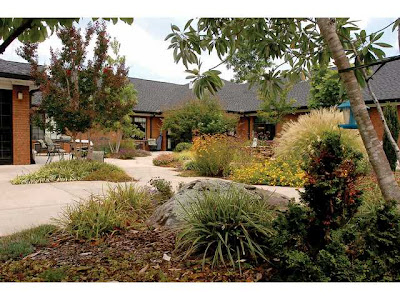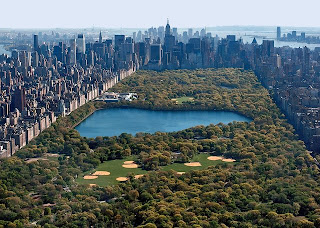Healing Garden
Guest Book Entries from Emanuel Children’s Hospital Garden, Portland, OR
October 5, 2008
Paynseville Area Hospital Foundation Meditation Garden
October 4, 2008
Jennifer Shinn, Director and Volunteer Coordinator for the Paynesville Area Health Care System recently wrote in about the hospital’s new Meditation Garden, a wonderful example of grassroots community effort. Here’s what she had to say:
“We are a small healthcare facility that has received such wonderful gifts from community members and our landscape designer to make the first phase of our Meditation Garden possible – all through donations! I would like to share a ‘before’ photo so you can better understand the full transformation that has happened here in Paynesville.

Our staff, healthcare recipients and visitors use this newly reformed space everyday! Although our plants are ‘newbies,’ the space provides so much more than the original mission sought out to do! When you visit you are taken away from wherever you are at in your day and brought into a place where you would envision you could revive your inner soul.
We are so grateful that philanthropy has created this first phase of our
The Paynesville Area Health Care System is located in
You can contact Jennifer Shinn directly for more information at 320-243-7938, or email JShinn@pahcs.com
Open Spaces Sacred Places – New Book from TKF Foundation
October 1, 2008

So I’m looking on my own blog (this one) and one of the Google ads – “Open Spaces Sacred Places” – catches my eye. I’m not supposed to click on my own Google ads but this one I couldn’t resist, and low and behold, it’s a new book published by the TKF Foundation. This nonprofit’s mission is “to provide the opportunity for a deeper human experience by supporting the creation of public greenspaces that offer a temporary place of sanctuary, encourage reflection, provide solace, and engender peace.” The book is called Open Spaces Sacred Places, by Tom Stoner and Carolyn Rapp, and you can order it from the TKF website. I don’t have a copy yet, but am looking forward to getting my hands on one and reviewing it for this blog. Or if anyone else out there has read it and would like to write a guest review, I’m all for that, too.
Back to School: Healthcare Garden Design Certification Program at Chicago Botanic Garden
September 18, 2008
CERTIFICATION COURSE OFFERS INSIGHT AND INSPIRATION
Healing Gardens in Prisons
September 2, 2008
Gainesville Times article on healing gardens
August 25, 2008
Healthy Monday: Greenery good for patients, health facilities
Sometimes, nature is the best medicine.
More health care facilities are using the outdoor environment as a way to help both patients and visitors feel better. Known as “healing gardens” or “therapeutic landscapes,” these green spaces have proven to be so beneficial that hospitals and nursing homes have begun incorporating them into their construction plans.
Northeast Georgia Medical Center’s two upcoming additions to its main campus, the Women & Children’s Pavilion and the North Patient Tower, both include healing gardens in their design. And at least one local nursing home, The Oaks at Limestone off Limestone Parkway, has been using a therapeutic garden for several years. There’s a bubbling fountain in the interior courtyard, and colorful native flowers planted throughout the grounds. Strategically placed bird feeders almost guarantee a display of wildlife throughout the day.
“The families really, really love it,” said administrator Dorothy Foster. “The water fountain is really soothing. When residents are able to go outside, they love just sitting and enjoying the sound of the water.” Foster said the nursing home’s employees also find it a relaxing place to take a break.
Naomi Sachs, executive director of the Therapeutic Landscapes Resource Center in New York, said studies have shown that when patients have a view of the outdoors, they need less pain medication and have shorter hospital stays. This knowledge has brought about a revolution in health care design, Sachs said. “In the 1960s, when hospitals got air conditioning and began closing their windows, they kind of turned their backs on the outdoors,” she said. “(But) a lot of research has been done by environmental psychologists, starting in the mid-1970s. It shows that people respond to a wealth of greenery, a really lush environment (rather than to just a few boxed plants).”
“In a hospital setting, where people are very much not in control of their own bodies and their own routines, and there is a huge lack of privacy, naturalistic settings can be an antidote to that,” Sachs said. “It’s a distraction to whatever problem the patient or visitor or caregiver may have.”
While the gardens are beautiful, they’re far more than just a pleasant amenity. “Savvy hospitals are realizing that it helps their bottom line,” Sachs said. The environment also may play a role in why people choose one facility over another. If they had a positive experience, whether as a patient or as an employee, they’re likely to recommend that place to others. “The fact that people are happier can become a marketing tool,” Sachs said. “More and more health care centers are starting to catch onto that.”
“Isn’t every garden a healing garden?” Part II
Healing Garden at Good Samaritan Cancer Center, Puyallup, WA
“A healing garden is an outdoor (and sometimes green indoor) space designed to promote and improves people’s health and well-being. A true healing garden must be successful in fulfilling the design intent.” Naomi Sachs and the Therapeutic Landscapes Resource Center’s working definition of “healing gardens.”
In my post yesterday, I gave my very broad definition of “Landscapes for Health,” (recap: A Landscape for Health is defined as any landscape that promotes and facilitates health and well-being). And I left you with a cliffhanger, promising to define “healing gardens” today. And none too soon, as I seem to have already caused confusion, as evidenced by Henry’s comment on yesterday’s post and a friend’s email to me:
“So is a playground a healing garden?? (Slightly joking/slightly serious.) The best way to get my daughter to forget she has teething pain is to take her to the playground and the best way to help mom forget she is tired and overwhelmed is to take her to the playground – her joy makes us both forget the owie.” – K.W.
Is a playground a Landscape for Health? Absolutely, according to my definition and my friend’s experience. But is it a healing garden? Maybe. Depends who designed it, for whom, and why. I agree with Henry that we need a more narrow and specific definition for healing gardens, one that refers to outdoor (and some green indoor) spaces that are designed, preferably with Evidence-Based Design (EBD), to have healing effects on the people using them.
I have a confession: I started the Therapeutic Landscapes Database in 1999, and have been avoiding coming up with a simple, one-or-two-sentence definition for “healing gardens” ever since. I find it to be extremely daunting, and others must, too, because nine years later, there is still no agreed-upon, industry-standard definition that I can blithely quote. Maybe that’ll happen someday soon, but for now there’s a lot of confusion around the terminology. The American Horticultural Therapy Association (AHTA) just recently issued a Position Paper with helpful definitions of some terms including “healing gardens,” “therapeutic gardens,” and “restorative gardens,” among others. I’ve included some of those definitions below, along with other discussions, but today I’ve finally come up with my own working definition, which means that it is still very much subject to discussion and change. I hope people will leave comments and constructive criticism about what I’ve got so far.
I have a pet peeve about people’s overzealous use of dictionary definitions, but in this case I think that’s a good starting point:
1. Healing: The Oxford English Dictionary gives four definitions for the verb “heal”:
a. To become sound or healthy again;
b. To cause (a wound, a disease, or a person) to heal or be healed;
c. To put right (differences, etc.);
d. To alleviate (sorrow, etc.).
So “healing” implies making someone well, or at least improving the health of someone who is or was not well.
A healing garden is an outdoor (and sometimes green indoor) space designed to promote and improve people’s health and well-being. A true healing garden must be successful in fulfilling the design intent of healing. Positive outcomes can be achieved through passive experience of the garden (viewing of or presence in the garden) and/or active involvement in and with the garden (gardening, rehabilitative therapy, and other activities).
And then there are all the other terms, like restorative landscapes, and wellness gardens, and therapeutic gardens, but I’m going to save that for another day.
If you feel like reading more, I would suggest:
1. The American Horticultural Therapy Association (AHTA) recently-released Position Paper on Definitions and Positions:
Types of Gardens
Healing Gardens
Healing gardens are plant dominated environments including green plants, flowers, water, and other
aspects of nature. They are generally associated with hospitals and other healthcare settings,
designated as healing gardens by the facility, accessible to all, and designed to have beneficial effects on
most users. A healing garden is designed as a retreat and a place of respite for clients, visitors, and
staff and to be used at their desire. Healing gardens may be further divided into specific types of
gardens including therapeutic gardens, horticultural therapy gardens, and restorative gardens. These
garden types are likely to have overlap and the following definitions should be regarded as guidelines
since no two gardens are the same.
Therapeutic Gardens
A therapeutic garden is designed for use as a component of a treatment program such as occupational
therapy, physical therapy, or horticultural therapy programs and can be considered as a subcategory of a
healing garden. A garden can be described as being therapeutic in nature when it has been designed to
meet the needs of a specific user or population. It is designed to accommodate client treatment goals
and may provide for both horticultural and non-horticultural activities. It should be designed as part of a
multi-disciplinary collaborative process by a team of professionals. A therapeutic garden may exist on its
own as an extension of an indoor therapeutic program area or it may be part of a larger healing garden.
Horticultural Therapy Gardens
A horticultural therapy garden is a type of therapeutic garden; it is designed to accommodate client
treatment goals, but it is designed to support primarily horticultural activities. A horticultural therapy
garden is also designed in such a manner that the clients themselves are able to take care of plant
material in the garden.
Restorative Gardens
A restoration or meditation garden may be a public or private garden that is not necessarily associated
with a healthcare setting. This type of garden employs the restorative value of nature to provide an
environment conducive to mental repose, stress-reduction, emotional recovery, and the enhancement of
mental and physical energy. The design of a restorative garden focuses on the psychological, physical,
and social needs of the users.
2. Annalisa Gartman Vapaa has a nice discussion of the definition of healing gardens on page three of her masters thesis, Healing Gardens: Creating Places for Restoration, Meditation, and Sanctuary,” MLA thesis for Virginia Polytechnic Institute and State University, 2002.
3. Clare Marcus and Marni Barnes on pages 3-4 of Healing Gardens: Therapeutic Benefits and Design Recommendations (see this recent post for more on this book).
4. Jain Malkin in her fabulous new book A Visual Reference for Evidence-Based Design, on pages 4-6, and 132.
5. Henry Domke suggested this definition: “A healing garden is created using design informed by credible research to achieve the best possible health outcomes,” a modification of the recently revised definition of “Evidence-Based Design” from the Center for Health Design.
“Isn’t every garden a healing garden?” Part I
August 23, 2008

“Healing Environment” vs. “Healthy Environment”
August 1, 2008
Information needed, and a favorite children’s and rooftop garden
July 19, 2008














